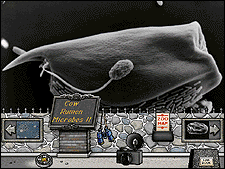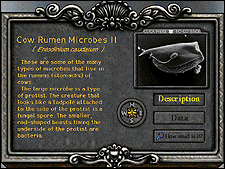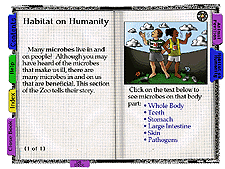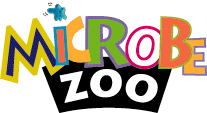 |
The
Microbe Zoo CD-ROM and Web Site
Click
to visit the web site
Click
to order online

CD-ROM sells for $34.98 plus shipping
and handling. Click
to order online or call 517-353-9229 to order by phone.
PI: Carrie Heeter
Project Director: Randy Russell
Chief Microbiologist and Multimedia Designer: Cathy McGowan
Art Director: Susanna Tellschow
Laser Scanning and Scanning Electron Microscopists: Joanne Whallon,
Shirley Owens
Version 2.0 Programming: Brian Winn
The Digital Learning Center for Microbial Ecology
(DLC-ME) is a science education project developed at Michigan State
University. The DLC-ME was created by the Comm Tech Lab in collaboration
with the Center for Microbial Ecology and the College of Education
at Michigan State.
The goal of the DLC-ME and the Microbe Zoo is
to help students from age 7 to 107 learn about microbial ecology,
the study of microbes in the environment. This project was partially
funded by a grant from the National Science Foundation, 1994-1996.
AWARDS
-- SCILINKS, National Science Teachers Association,
November, 2001 and May, 2002
-- Reviewed in the Journal
of Biological Education, March 2002
-- Exploratorium's Ten Cool Sites Award for educational excellence
for May, 2002
-- added to the MERLOT distinguished, high-quality learning materials
collection, February, 2002
-- selected for schoolsnet web guide (UK), March, 2001
-- BlueWebn Award, 1999
-- rated "Spectacular!" and awarded 5 stars in a 3/17/99
syndicated newspaper column "Surfing the Net with Kids."
-- listed on BBC Best of Science on the Web, 1999
-- exhibited at SIGGRAPH, 1995
-- Health Explorer Site of the Week, 1998
-- five star rating by NetGuide, 1998
-- New Media Invision Multimedia Award Finalist, 1996
WEB SITE
The web site includes four areas:
The Microbe Zoo
a virtual zoo filled with exotic specimens. Instead of lions, elephants,
and zebras, this zoo is stocked with strange creatures from the
microscopic worlds around, inside of, and on us. The zoo includes
pictures of microbes; data about their size, scientific classification,
feeding habitats, and more; and descriptions of how the microbes
fit into and interact with their environment and other microorganisms.
Zoo specimens are arranged in pavilions representing the habitats
in which they naturally dwell, such as Water World, DirtLand, and
the Animal Pavilion. Subsections of the zoo pavilions representing
specific microbial habitats include the compost heap, the toxic
waste dump, habitat on humanity, the termite gut, the house of horrors,
and several others.
Microbes in the News
news stories from the popular press related to microbial ecology
and microbiology, with added commentary from scientists. Stories
are grouped into four categories: Heroic, Dangerous, Ancient and
Strange. Articles are listed in chronological order based on publication
dates, as well as by groupings based on what newspaper or magazine
they originally appeared in.
Meet the Scientists
meet scientists who study microbes and microbial ecology. Science
is not merely a collection of facts; it is an activity and an occupation
for many people. Find out more about the people behind the microbes.
Scientists are listed two ways: grouped by their areas of expertise
and listed alphabetically by name.
Microbial Ecology Resources
a list of resources related to microbial ecology, microbiology,
and biology of potential interest to students and teachers. Includes
lists of World-Wide Web sites, CD-ROMs and other software, videotapes,
books, periodicals, conferences, catalogs, science museums and other
resources. Resources can be looked up based on title, author's name,
or by media type (such as book, video, software, etc.).
CD-ROM
|
 |
 |

The Microbe Zoo provides access to five pavilions covering
22 native habitats

Ag Acres, Compost Pile, Redox Mine, and the Root Cellar
are just a few of the habitats found in Dirtland

Clicking on a habitat zooms in to show the microbes larger
than life in their zoo cage

Information plaques describe each microbe's characteristics,
size, and scientific information

The lab book contains illustrations, photos and interactive
animations that expand on concepts in the zoo
|

Version 2 of the CD-ROM
now available!
The Microbe Zoo invites young people
to actively explore the hidden world of microbes through
an appealing, fun interface.
Rather than visit the "Lion House"
or the "Monkey House," learners go to microbe
habitats such as dirt, water, and inside of humans and animals.
At the "Snack Shop," you can look at the microbes
that live in snacks, rather than eating snacks.
Within each habitat, students zoom down
to individual microbe "cages" to see and learn
about the microbe. Each cage contains a plaque that provides
information on the microbe and its habitat. The "Size
Machine" allows the students to get a feel for the
relative size of the creature they are looking at.
In addition to exploring through the zoo
interface, students can search for microbe specimens based
on Microscope Type and/or Microbe Classification using the
'crobe 2000 database.
The CD-ROM includes more than 150 microbe
specimens. All specimens include textual descriptions, full-screen
pictures, and audio pronunciations of their names.
As the student explores the zoo, various
tools are available to enhance and record their experiences.
The Scientist's Lab Notebook provides extensive background
on microbial habitats. A glossary provides definitions.
Within each habitat, a guide provides audio narration and
insightful information. A notepad allows the student to
jotting down (and saving and printing) their impressions.
A camera (with lot's of film) is available for taking pictures
of their favorite microbes.
Scientists and students alike delight
in this appealing window to the unseen world of microbes.
The Microbe Zoo was partially funded
by a grant from the National Science Foundation and developed
by the Communication Technology Lab and the Center for Microbial
Ecology at Michigan State University.
The Microbe Zoo
CD-ROM runs on
- Power Macintosh with MacOS 8 or better
- Pentium compatible PCs with Windows
95/98/2000/NT
|
|
 |

